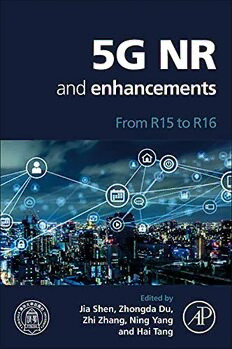
5G NR and Enhancements: From R15 to R16 PDF
Preview 5G NR and Enhancements: From R15 to R16
5G NR and Enhancements This pageintentionallyleftblank 5G NR and Enhancements From R15 to R16 Editedby JIA SHEN Standard Research Department, OPPO Research Institute, Shenzhen,China ZHONGDA DU Standard Research Department, OPPO Research Institute, Shenzhen,China ZHI ZHANG Standard Research Department, OPPO Research Institute, Shenzhen,China NING YANG Standard Research Department, OPPO Research Institute, Shenzhen,China HAI TANG Vice presidentof OPPO Research Institute, Shenzhen,China Elsevier Radarweg29,POBox211,1000AEAmsterdam,Netherlands TheBoulevard,LangfordLane,Kidlington,OxfordOX51GB,UnitedKingdom 50HampshireStreet,5thFloor,Cambridge,MA02139,UnitedStates Copyright©2022ElsevierInc.Allrightsreserved. Nopartofthispublicationmaybereproducedortransmittedinanyformorbyanymeans, electronicormechanical,includingphotocopying,recording,oranyinformationstorageand retrievalsystem,withoutpermissioninwritingfromthepublisher.Detailsonhowtoseek permission,furtherinformationaboutthePublisher’spermissionspoliciesandour arrangementswithorganizationssuchastheCopyrightClearanceCenterandtheCopyright LicensingAgency,canbefoundatourwebsite:www.elsevier.com/permissions. Thisbookandtheindividualcontributionscontainedinitareprotectedundercopyrightby thePublisher(otherthanasmaybenotedherein). Notices Knowledgeandbestpracticeinthisfieldareconstantlychanging.Asnewresearchand experiencebroadenourunderstanding,changesinresearchmethods,professionalpractices, ormedicaltreatmentmaybecomenecessary. Practitionersandresearchersmustalwaysrelyontheirownexperienceandknowledgein evaluatingandusinganyinformation,methods,compounds,orexperimentsdescribed herein.Inusingsuchinformationormethodstheyshouldbemindfuloftheirownsafety andthesafetyofothers,includingpartiesforwhomtheyhaveaprofessionalresponsibility. Tothefullestextentofthelaw,neitherthePublishernortheauthors,contributors,or editors,assumeanyliabilityforanyinjuryand/ordamagetopersonsorpropertyasamatter ofproductsliability,negligenceorotherwise,orfromanyuseoroperationofanymethods, products,instructions,orideascontainedinthematerialherein. BritishLibraryCataloguing-in-PublicationData AcataloguerecordforthisbookisavailablefromtheBritishLibrary LibraryofCongressCataloging-in-PublicationData AcatalogrecordforthisbookisavailablefromtheLibraryofCongress ISBN:978-0-323-91060-6 ForInformationonallElsevierpublications visitourwebsiteathttps://www.elsevier.com/books-and-journals Publisher:GlynJones EditorialProjectManager:NaomiRobertson ProductionProjectManager:KameshRamajogi CoverDesigner:GregHarris TypesetbyMPSLimited,Chennai,India Contents Listofcontributors xix Preface xxiii 1. Overview 1 JinxiSu,JiaShen,WendongLiuandLiGuo 1.1 Introduction 1 1.2 EnhancedevolutionofnewradiooverLTE 3 1.2.1 Newradiosupportsahigherbandrange 4 1.2.2 Newradiosupportswidebandwidth 5 1.2.3 Newradiosupportsmoreflexibleframestructure 5 1.2.4 Newradiosupportsflexiblenumerology 6 1.2.5 Low-latencyenhancementsofairinterfacebynewradio 7 1.2.6 Enhancementofreferencesignalsinnewradio 8 1.2.7 Multipleinputmultipleoutputcapabilityenhancement bynewradio 9 1.2.8 Enhancementofterminalpowersavingbynewradio 10 1.2.9 Mobilityenhancementbynewradio 12 1.2.10 Enhancementofqualityofserviceguaranteebynewradio 13 1.2.11 Enhancementofcorenetworkarchitectureevolution bynewradio 14 1.3 Newradio’schoiceofnewtechnology 15 1.3.1 Newradio’schoiceonnewnumerology 16 1.3.2 Newradio’schoiceonnewwaveform 17 1.3.3 Newradio’schoiceonnewcoding 21 1.3.4 Newradio’schoiceonnewmultipleaccess 22 1.4 Maturityof5Gtechnology,devices,andequipment 24 1.4.1 Thedevelopmentandmaturityofdigitaldevicesandchips havewellsupportedtheresearchanddevelopment needsof5Gequipment 24 1.4.2 5Gactivelarge-scaleantennaequipmentcanmeetthe engineeringandcommercialrequirements 25 1.4.3 Millimeterwavetechnology—devicesandequipmentare becomingmoreandmoremature 27 1.5 R16enhancementtechnology 29 1.5.1 Multipleinputmultipleoutputenhancement 29 1.5.2 Ultrareliableandlowlatencycommunications enhancement-physicallayer 31 v vi Contents 1.5.3 Ultrareliableandlowlatencycommunicationsenhancement highlayer 32 1.5.4 UEpower-savingenhancement 33 1.5.5 Two-stepRACH 33 1.5.6 Uplinkbandswitchingtransmission 33 1.5.7 Mobilityenhancement 34 1.5.8 Multi-RATdualconnectivityenhancement 35 1.5.9 Newradio(cid:1)vehicletoeverything 36 1.5.10 Newradio-unlicensed 36 1.6 Summary 37 References 38 2. Requirementsand scenarios of5G system 41 WenqiangTianandKevinLin 2.1 Currentneedsandrequirementsinthe5Gera 41 2.1.1 Requirementsofhighdatarate 41 2.1.2 Requirementsfromverticalindustries 43 2.2 Typicalscenarios 44 2.2.1 Enhancedmobilebroadband 45 2.2.2 Ultrareliableandlowlatencycommunications 46 2.2.3 Massivemachinetypecommunications 46 2.3 Keyindicatorsof5Gsystems 47 2.4 Summary 51 References 51 3. 5G system architecture 53 JianhuaLiu,NingYangandTricciSo 3.1 5Gsystemarchitecture 53 3.1.1 5Gsystemarchitecturerequirements 53 3.1.2 5Gsystemarchitectureandfunctionalentities 56 3.1.3 5Gend-to-endarchitectureandprotocolstackbasedon 3rdGenerationPartnershipProjectaccess 60 3.1.4 5Gend-to-endarchitectureandprotocolstackbasedon non-3rdGenerationPartnershipProjectaccess 62 3.1.5 5Gsystemidentifiers 64 3.2 The5GRANarchitectureanddeploymentoptions 69 3.2.1 DescriptionofEN-DCandSAarechitecture 75 3.3 Summary 82 References 82 Furtherreading 83 Contents vii 4. Bandwidth part 85 JiaShenandNandeZhao 4.1 Basicconceptofbandwidthpart 85 4.1.1 Motivationfromresourceallocationswithmultiplesubcarrier spacings 86 4.1.2 MotivationsfromUEcapabilityandpowersaving 89 4.1.3 Basicbandwidthpartconcept 92 4.1.4 Usecasesofbandwidthpart 93 4.1.5 Whatifbandwidthpartcontainssynchronizationsignal/physical broadcastchannelblock? 95 4.1.6 Numberofsimultaneouslyactivebandwidthparts 96 4.1.7 Relationbetweenbandwidthpartandcarrieraggregation 98 4.2 Bandwidthpartconfiguration 101 4.2.1 IntroductionofcommonRB 101 4.2.2 GranularityofcommonRB 102 4.2.3 Referencepoint—pointA 104 4.2.4 ThestartingpointofcommonRB—RB0 109 4.2.5 Indicationmethodofcarrierstartingpoint 109 4.2.6 Bandwidthpartindicationmethod 110 4.2.7 Summaryofthebasicbandwidthpartconfigurationmethod 111 4.2.8 Numberofconfigurablebandwidthparts 113 4.2.9 BandwidthpartconfigurationintheTDDsystem 115 4.3 Bandwidthpartswitching 117 4.3.1 Dynamicswitchingversussemistaticswitching 117 4.3.2 IntroductionofbandwidthpartactivationmethodbasedonDCI 118 4.3.3 DCIdesignfortriggeringbandwidthpartswitching—DCIformat 119 4.3.4 DCIdesignfortriggeringbandwidthpartswitching—“explicitly trigger”versus“implicitlytrigger” 123 4.3.5 DCIdesignfortriggeringbandwidthpartswitching—bandwidth partindicator 125 4.3.6 Introductionoftimer-basedbandwidthpartfallback 127 4.3.7 Whethertoreusediscontinuousreceptiontimertoimplement bandwidthpartfallback? 131 4.3.8 Bandwidthpartinactivitytimerdesign 135 4.3.9 Timer-baseduplinkbandwidthpartswitching 138 4.3.10 Time-pattern-basedbandwidthpartswitching 139 4.3.11 Automaticbandwidthpartswitching 143 4.3.12 Bandwidthpartswitchingdelay 145 4.4 Bandwidthpartininitialaccess 148 4.4.1 IntroductionofinitialDLbandwidthpart 148 viii Contents 4.4.2 IntroductionofinitialULbandwidthpart 152 4.4.3 InitialDLbandwidthpartconfiguration 154 4.4.4 RelationshipbetweentheinitialDLbandwidthpartanddefault DLbandwidthpart 159 4.4.5 Initialbandwidthpartincarrieraggregation 160 4.5 Impactofbandwidthpartonotherphysicallayerdesigns 161 4.5.1 Impactofbandwidthpartswitchingdelay 161 4.5.2 Bandwidthpart-dedicatedandbandwidthpart-common parameterconfiguration 162 4.6 Summary 163 References 163 5. 5G flexiblescheduling 167 YananLin,JiaShenandZhenshanZhao 5.1 Principleofflexiblescheduling 167 5.1.1 LimitationofLTEsystemschedulingdesign 167 5.1.2 Schedulingflexibilityinthefrequencydomain 169 5.1.3 Schedulingflexibilityinthetimedomain 171 5.2 5Gresourceallocation 176 5.2.1 Optimizationofresourceallocationtypesinthe frequencydomain 177 5.2.2 Granularityofresourceallocationinthefrequencydomain 181 5.2.3 Frequency-domainresourceindicationduringBWPswitching 185 5.2.4 Determinationoffrequency-hoppingresourcesinBWP 188 5.2.5 Introductiontosymbol-levelscheduling 194 5.2.6 Referencetimeforindicationofstartingsymbol 196 5.2.7 ReferenceSCSforindicationofK orK 199 0 2 5.2.8 Resourcemappingtype:typeAandtypeB 200 5.2.9 Time-domainresourceallocation 202 5.2.10 Multislottransmission 210 5.3 CodeBlockGroup 214 5.3.1 IntroductionofCodeBlockGrouptransmission 214 5.3.2 CBGconstruction 216 5.3.3 CBGretransmission 217 5.3.4 DLcontrolsignalingforCBG-basedtransmission 219 5.3.5 ULcontrolsignalingforCBG-basedtransmission 219 5.4 DesignofNRPDCCH 223 5.4.1 ConsiderationsofNRPDCCHdesign 223 5.4.2 ControlResourceSet 226 5.4.3 Search-spaceset 236 Contents ix 5.4.4 DCIdesign 241 5.5 DesignofNRPUCCH 249 5.5.1 Introductionofshort-PUCCHandlong-PUCCH 249 5.5.2 Designofshort-PUCCH 250 5.5.3 Designoflong-PUCCH 253 5.5.4 PUCCHresourceallocation 257 5.5.5 PUCCHcollidingwithotherULchannels 261 5.6 FlexibleTDD 264 5.6.1 Flexibleslot 264 5.6.2 Semistaticuplink(cid:1)downlinkconfiguration 266 5.6.3 Dynamicslotformatindicator 269 5.7 PDSCHratematching 270 5.7.1 Considerationsforintroducingratematching 270 5.7.2 Rate-matchingdesign 274 5.8 Summary 279 References 279 6. NR initial access 283 WeijieXu,ChuanfengHe,WenqiangTian,RongyiHuandLiGuo 6.1 Cellsearch 284 6.1.1 Synchronizationrasterandchannelraster 284 6.1.2 DesignofSSB 290 6.1.3 TransmissionofSSB 295 6.1.4 PositionofactuallytransmittedSSBsandindicationmethods 300 6.1.5 Cell-searchprocedure 303 6.2 Commoncontrolchannelduringinitialaccess 308 6.2.1 SSBandCORESET#0multiplexingpattern 309 6.2.2 CORESET#0 313 6.2.3 Type0(cid:1)PDCCHsearchspace 316 6.3 NRrandomaccess 320 6.3.1 DesignofNRPRACH 320 6.3.2 NRPRACHresourceconfiguration 326 6.3.3 PowercontrolofPRACH 332 6.4 RRMmeasurement 334 6.4.1 ReferencesignalsforRRM 335 6.4.2 MeasurementgapinNR 337 6.4.3 NRintrafrequencyandinterfrequencymeasurement 346 6.4.4 SchedulingrestrictionscausedbyRRMmeasurement 354 6.5 Radiolinkmonitoring 356
